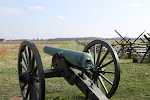In the 1950s, the Cold War was steadily building with many Americans convinced nuclear war with the Soviet Union was inevitable. Some military officials even advocated a first strike to take out the Soviets, although it would mean the annihilation of some American targets in retaliation.
In 1955, the U.S. military conducted a large training exercise encompassing a substantial portion of Louisiana. The purpose of “Operation Sagebrush” was to evaluate the effectiveness of military operations in a nuclear war. The largest joint Army and Air Force maneuvers since World War II involved nearly 150,000 troops.
A provisional army, meant to represent U.S. forces, was built around the 1st Armored Division and an opposing force was created around the 82nd Airborne Division. Air Force bombers, fighter planes, and other aircraft crisscrossed Louisiana’s skies, stirring great interest among the many citizens who had never seen a helicopter.
Many communities throughout Louisiana were inundated with troops and airmen. Ruston saw the arrival of an ordnance detail of the Air Force’s 727th Aircraft Control and Warning Squadron in October before the maneuvers began. As many as 700 airmen
operated out of Ruston, camping on the grounds of the Methodist Children’s Home next to the municipal airport and at the fairgrounds nearby. The airport served as the home base of the 69th Signal Battalion’s three light planes, two large planes, and three helicopters. Residents in Sabine and Vernon Parishes spotted giant 280mm atomic cannons capable of firing atomic artillery shells. Heavy tanks chewed up roads in many communities.
As with the huge military maneuvers in Louisiana during World War II, interaction between the troops and the locals developed into friendships and more serious relationships. While 24-year old Dick Paige was stationed in Ruston, he met and fell in love with 20-year old Mary Belle Lee of Simsboro. Paige’s reassignment after Operation Sagebrush didn’t cool the relationship—they married in 1957. After Paige’s retirement from the Air Force, they moved back to Ruston where he pastored Baptist churches for nearly 40 years.
 |
| U.S. Army troops prepare for an Operation Sagebrush mission. |
Although the military had accepted racial integration in 1948, segregation still ruled much of the South in 1955. On the last day of Operation Sagebrush, December 1, Rosa Parks would be arrested for refusing to give up her Montgomery, Alabama bus seat to a white passenger. In a press briefing, an Operation Sagebrush official attempted to quell fears that the Army’s integrated units would cause trouble in segregated Louisiana, such as black servicemen trying to use a whites-only facility. He noted, “When you get 150,000 people together for anything, you’re bound to have some unpleasant incidents, and the same is true in the case of the military. We respect local policies. On duty there is no segregation but off duty, all our personnel is to respect local customs.”
 |
Huge 280mm cannons capable of
hurling an atomic shell 20 miles
were mobilized in Operation
Sagebrush.Add caption |
Operation Sagebrush tested the idea of air cavalry—moving troops quickly by helicopter. While the strategy increased exponentially the ability of units to find and fight the enemy on the nuclear battlefield, a number of problems remained, including fire support for the airmobile units. To protect troops outside the range of artillery, many in the Army advocated using its own armed helicopters and slow-moving fixed wing aircraft to considerable Air Force opposition. The Air Force did not want the Army having its own close air support aircraft and wanted primary control over strategic nuclear warfare. Even use of unarmed helicopters in Operation Sagebrush was fought furiously by the Air Force which wanted exclusive use of the skies.
The operation resulted in the development of Fort Polk near Leesville into a permanent installation and the 1st Armored Division was reassigned from Fort Hood, Texas to continue to test mobility and combat strategies for the nuclear age. The 1st Armored, with its modern M-48 Patton Tanks and new helicopters, remained at Fort Polk until June 1959 before returning to Fort Hood.















Is there a list of men who were casualties during the operation.
ReplyDelete